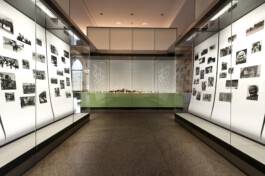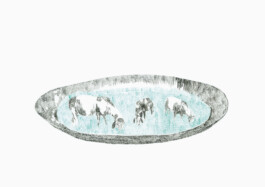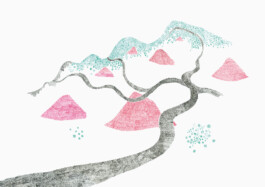My Swabian Self?





Installation view Landesmuseum Württemberg © Landesmuseum Württemberg, Stuttgart; Photo: Franziska Schneider
Installation view Landesmuseum Württemberg © Landesmuseum Württemberg, Stuttgart; Photo: Franziska Schneider
Installation view Landesmuseum Württemberg © Landesmuseum Württemberg, Stuttgart; Photo: Franziska Schneider
Installation view Landesmuseum Württemberg © Landesmuseum Württemberg, Stuttgart; Photo: Franziska Schneider
Installation view Landesmuseum Württemberg © Landesmuseum Württemberg, Stuttgart; Photo: Franziska Schneider
MY SWABIAN SELF?
‘Every [culture] is a more or less permanent direction, a behaviour, a twist, a configuration given to that which has no figure in itself, but whose outline, whose drawing reveals a new aspect.’ (Jean-Luc Nancy: Identity, Vienna 2010, p. 65)
Gabriela Oberkofler approaches the question of the contemporary Swabian self by using six individual stories of Swabians with Turkish roots to show how cultures and identities complement each other.
Based on intensive conversations between her and six members of the German-Turkish Forum, the installations of the South Tyrolean-born artist, who has lived in Stuttgart for over 15 years, combine personal objects, drawings and animations with historical artefacts from the State Museum and archive material to create subtle portrayals of different personalities. She deconstructs the Swabian self by juxtaposing the private and individual with stereotypes and clichés.
FOR ERGUN CAN: CARNIVAL
Carnival masks (hand-carved by Ergun Can), wallpaper with drawings after votive figures from the collection of the Innsbruck Folklore Museum
Ali Ergun Can was born in Istanbul in 1958. After training as an industrial mechanic, he studied mechanical engineering and now lives and works in Stuttgart. He moved with his family from Istanbul to a village in the Black Forest when he was five years old. As a teenager, he became interested in the traditional Swabian carnival—especially the hand-carved masks—and learnt how to carve them. Ergun Can is the only Muslim mask carver.
Gabriela Oberkofler juxtaposes selected masks from the Black Forest made by Ergun Can with a wallpaper featuring her own drawings of votive figures from Tyrol and South Tyrol.
FOR FUNDA DOGHAN: BUTTERFLY
Cat toy by Funda Doghan, votive figurines from the Landesmuseum Württemberg, Gefädelte Schmetterlinge, 2016, watercolour on paper, 80 × 80 cm
Schwäbisch kam mir immer so grob an die Ohren, recalls the journalist, who was born in Ulm in 1984. Nevertheless, Funda Doghan calls the cat toy in the display case Mäusle (little mouse); she likes the playfulness of the Swabian diminutives. Her soul animal symbolises change in relation to her homeland: the butterfly, which can emerge and take wing. As a symbol of hope and lightness, it is present in two forms: a butterfly native to Turkey and one from southern Germany. However, freedom always also means detachment from the strings on which the two butterflies are still hanging.
CHAIN
Zeichnung Gebetskette, 2016, Aquarell auf Papier, 80 × 80 cm,
Fraiskette aus Tierknochen, Rosenkranz mit Anhänger (2. Hälfte 18. Jahrhundert)
Zeichnung Blaue Blume, 2015, Aquarell auf Papier, 21 × 15 cm
Gabriela Oberkofler verknüpft in ihrer Installation christliche und muslimische Gebetsketten – in beiden Religionen werden diese für meditative Andachten gebraucht.
Drawing Gebetskette (Prayer chain), 2016, watercolour on paper, 80 × 80 cm,
Frais necklace made from animal bones, rosary with pendant (2nd half of the 18th century)
Drawing Blaue Blume (Blue Flower), 2015, watercolour on paper, 21 × 15 cm
Gabriela Oberkofler combines Christian and Muslim prayer chains in her installation - in both religions these are used for meditative devotions.
FÜR MEHMET SOYLU: WANDERN
Cot figurines (cot animals from southern Germany and Tyrol, 18th and 19th century),
Bowl (Susanne Goldbach, Württemberg State Museum),
Ceramic paprika (Gabriela Oberkofler),
Wooden frame (Landesmuseum),
Wooden casket with horse tooth from South Tyrol,
Drawings Für Mehmet (For Mehmet), 2016, watercolour on paper, various formats,
Drawing Tränenteppich (Tear carpet), 2015, watercolour on paper, 21 × 30 cm,
Family photographs by Mehmet Soylu, Stuttgart,
Swabian Alb and Antakya, Anatolia,
Photographs from Württemberg between 1910 and 1960
(State Centre for Folklore / Württemberg State Museum) and
Photographs of the Yilmaz family between 1940 and 1960,
Istanbul / Eskisehir / Dogancayir, Central Anatolia
For the computer scientist, hiking means more than just getting to know his home country better. For Mehmet Soylu, who was born in Eregli, Turkey, in 1952, the German-Turkish hiking group, which he founded in 2005, offers the opportunity for an exchange between cultures. Gabriela Oberkofler stages an installation across several display cases on the question of how we perceive the rural environment and how this is characterised by the cultural context: She combines family photos of the Soylus and a stuffed pepper, a dish that Mehmet Soylu likes to cook. It is immediately apparent how universal the supposedly different cultures are; one thinks of the rewarding stop-off after hiking, of childhood and nature. The nativity figures have been removed from their Christian context and are sent on a quest for a better life by Gabriela Oberkofler—as a symbol of the migration society.
FÜR HEART NOWACK-ELIKIZ: PIANO
Piano, wallpaper with drawings from the series Alles Wieder Zurück (Everything back again) (2014)
Gönül Nowack-Çelikiz combines different cultures in her love of music—she plays Turkish protest songs as well as Auf der schwäb’schen Eisenbahn. Born in Istanbul in 1943, the pianist has lived in Esslingen for a long time, where she gives piano lessons at the music school and performs as a concert pianist herself. In front of the wallpaper printed with Gabriela Oberkofler’s drawings, Gönül Nowack-Çelikiz plays songs of different origins on several dates during the exhibition.
A project as part of the Great State Exhibition The Swabians: Between Myth and Brand.
Text: Birgit Gebhard and Maximilian Lehner













Unter- und Überwege, 2016, 13 drawings, watorcolour on paper, 20 × 30 cm
FOR BERKAY YILMAZ: FLYING, 2016, video installation, 2:11 minutes
Film (film sequences: Berkay Yilmaz, drawing: Gabriela Oberkofler and Julius Nägele, animation: Fuzzy (Martin Härtlein), editing: Sarah Beekmann and Fuzzy)
Berkay Yilmaz was born in Pforzheim in 1991 and is studying aerospace engineering at the University of Stuttgart. In his free time, he is passionate about flying gliders: he associates flying closely with his Swabian homeland and the Swabian tinkerer spirit with an affinity for technology - but also with the fulfilment of his longing to see his surroundings from a certain distance from above. Gabriela Oberkofler added sequences of her animated drawings to the film footage that Berkay Yilmaz shot of the Swabian Alb landscape he flew over, which visualise flying in a dreamlike, associative way.
My Swabian Self?





Installation view Landesmuseum Württemberg © Landesmuseum Württemberg, Stuttgart; Photo: Franziska Schneider
Installation view Landesmuseum Württemberg © Landesmuseum Württemberg, Stuttgart; Photo: Franziska Schneider
Installation view Landesmuseum Württemberg © Landesmuseum Württemberg, Stuttgart; Photo: Franziska Schneider
Installation view Landesmuseum Württemberg © Landesmuseum Württemberg, Stuttgart; Photo: Franziska Schneider
Installation view Landesmuseum Württemberg © Landesmuseum Württemberg, Stuttgart; Photo: Franziska Schneider
MY SWABIAN SELF?
‘Every [culture] is a more or less permanent direction, a behaviour, a twist, a configuration given to that which has no figure in itself, but whose outline, whose drawing reveals a new aspect.’ (Jean-Luc Nancy: Identity, Vienna 2010, p. 65)
Gabriela Oberkofler approaches the question of the contemporary Swabian self by using six individual stories of Swabians with Turkish roots to show how cultures and identities complement each other.
Based on intensive conversations between her and six members of the German-Turkish Forum, the installations of the South Tyrolean-born artist, who has lived in Stuttgart for over 15 years, combine personal objects, drawings and animations with historical artefacts from the State Museum and archive material to create subtle portrayals of different personalities. She deconstructs the Swabian self by juxtaposing the private and individual with stereotypes and clichés.
FOR ERGUN CAN: CARNIVAL
Carnival masks (hand-carved by Ergun Can), wallpaper with drawings after votive figures from the collection of the Innsbruck Folklore Museum
Ali Ergun Can was born in Istanbul in 1958. After training as an industrial mechanic, he studied mechanical engineering and now lives and works in Stuttgart. He moved with his family from Istanbul to a village in the Black Forest when he was five years old. As a teenager, he became interested in the traditional Swabian carnival—especially the hand-carved masks—and learnt how to carve them. Ergun Can is the only Muslim mask carver.
Gabriela Oberkofler juxtaposes selected masks from the Black Forest made by Ergun Can with a wallpaper featuring her own drawings of votive figures from Tyrol and South Tyrol.
FOR FUNDA DOGHAN: BUTTERFLY
Cat toy by Funda Doghan, votive figurines from the Landesmuseum Württemberg, Gefädelte Schmetterlinge, 2016, watercolour on paper, 80 × 80 cm
Schwäbisch kam mir immer so grob an die Ohren, recalls the journalist, who was born in Ulm in 1984. Nevertheless, Funda Doghan calls the cat toy in the display case Mäusle (little mouse); she likes the playfulness of the Swabian diminutives. Her soul animal symbolises change in relation to her homeland: the butterfly, which can emerge and take wing. As a symbol of hope and lightness, it is present in two forms: a butterfly native to Turkey and one from southern Germany. However, freedom always also means detachment from the strings on which the two butterflies are still hanging.
CHAIN
Zeichnung Gebetskette, 2016, Aquarell auf Papier, 80 × 80 cm,
Fraiskette aus Tierknochen, Rosenkranz mit Anhänger (2. Hälfte 18. Jahrhundert)
Zeichnung Blaue Blume, 2015, Aquarell auf Papier, 21 × 15 cm
Gabriela Oberkofler verknüpft in ihrer Installation christliche und muslimische Gebetsketten – in beiden Religionen werden diese für meditative Andachten gebraucht.
Drawing Gebetskette (Prayer chain), 2016, watercolour on paper, 80 × 80 cm,
Frais necklace made from animal bones, rosary with pendant (2nd half of the 18th century)
Drawing Blaue Blume (Blue Flower), 2015, watercolour on paper, 21 × 15 cm
Gabriela Oberkofler combines Christian and Muslim prayer chains in her installation - in both religions these are used for meditative devotions.
FÜR MEHMET SOYLU: WANDERN
Cot figurines (cot animals from southern Germany and Tyrol, 18th and 19th century),
Bowl (Susanne Goldbach, Württemberg State Museum),
Ceramic paprika (Gabriela Oberkofler),
Wooden frame (Landesmuseum),
Wooden casket with horse tooth from South Tyrol,
Drawings Für Mehmet (For Mehmet), 2016, watercolour on paper, various formats,
Drawing Tränenteppich (Tear carpet), 2015, watercolour on paper, 21 × 30 cm,
Family photographs by Mehmet Soylu, Stuttgart,
Swabian Alb and Antakya, Anatolia,
Photographs from Württemberg between 1910 and 1960
(State Centre for Folklore / Württemberg State Museum) and
Photographs of the Yilmaz family between 1940 and 1960,
Istanbul / Eskisehir / Dogancayir, Central Anatolia
For the computer scientist, hiking means more than just getting to know his home country better. For Mehmet Soylu, who was born in Eregli, Turkey, in 1952, the German-Turkish hiking group, which he founded in 2005, offers the opportunity for an exchange between cultures. Gabriela Oberkofler stages an installation across several display cases on the question of how we perceive the rural environment and how this is characterised by the cultural context: She combines family photos of the Soylus and a stuffed pepper, a dish that Mehmet Soylu likes to cook. It is immediately apparent how universal the supposedly different cultures are; one thinks of the rewarding stop-off after hiking, of childhood and nature. The nativity figures have been removed from their Christian context and are sent on a quest for a better life by Gabriela Oberkofler—as a symbol of the migration society.
FÜR HEART NOWACK-ELIKIZ: PIANO
Piano, wallpaper with drawings from the series Alles Wieder Zurück (Everything back again) (2014)
Gönül Nowack-Çelikiz combines different cultures in her love of music—she plays Turkish protest songs as well as Auf der schwäb’schen Eisenbahn. Born in Istanbul in 1943, the pianist has lived in Esslingen for a long time, where she gives piano lessons at the music school and performs as a concert pianist herself. In front of the wallpaper printed with Gabriela Oberkofler’s drawings, Gönül Nowack-Çelikiz plays songs of different origins on several dates during the exhibition.
A project as part of the Great State Exhibition The Swabians: Between Myth and Brand.
Text: Birgit Gebhard and Maximilian Lehner













Unter- und Überwege, 2016, 13 drawings, watorcolour on paper, 20 × 30 cm
FOR BERKAY YILMAZ: FLYING, 2016, video installation, 2:11 minutes
Film (film sequences: Berkay Yilmaz, drawing: Gabriela Oberkofler and Julius Nägele, animation: Fuzzy (Martin Härtlein), editing: Sarah Beekmann and Fuzzy)
Berkay Yilmaz was born in Pforzheim in 1991 and is studying aerospace engineering at the University of Stuttgart. In his free time, he is passionate about flying gliders: he associates flying closely with his Swabian homeland and the Swabian tinkerer spirit with an affinity for technology - but also with the fulfilment of his longing to see his surroundings from a certain distance from above. Gabriela Oberkofler added sequences of her animated drawings to the film footage that Berkay Yilmaz shot of the Swabian Alb landscape he flew over, which visualise flying in a dreamlike, associative way.